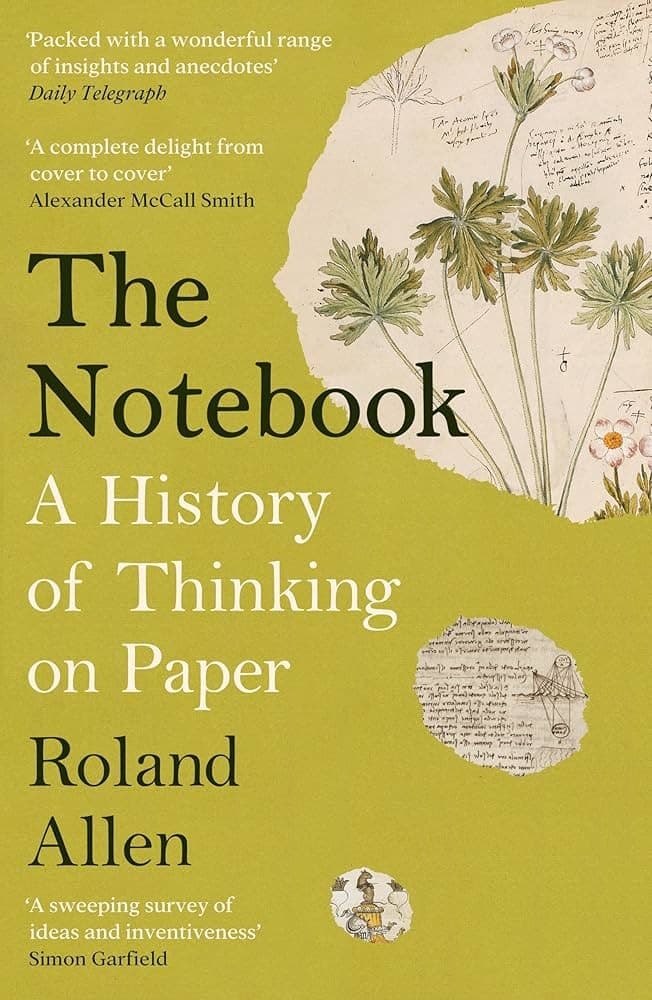
The Notebook
By Roland Allen
This book was written for me, and I am utterly convinced of it. It’s an absolute gem. For anyone who loves stationery as much as I do, this is a must-read. I even quoted it at length in my Paper Pro review.
Notes & Highlights
It even accorded with the classic principles of Italian design: like an espresso, a pair of Persol sunglasses or a Prada dress, le moleskine was minimal, functional and assertively black.
I prefer Leuchtturm1917 notebooks, though.
The oldest item that looks to modern eyes like a notebook sits in a display case in a castle in a Turkish city, [...]
The wreck is the oldest shipwreck yet excavated: it went down in about 1305 BCE, and its other contents confirm that we inherit the diptych from a sophisticated trading network.
Cai Lun, a Han dynasty eunuch, is said to have been responsible for the invention of paper, discovering that pulp vegetable fibres drained over a fine mesh dried into a durable, versatile and affordable material.
What makes the Farolfi ledger a key document in European history – indeed, world history – is that this wreck of a notebook is the first place where we see all the abstract concepts of accountancy, and the practical techniques by which they were managed, used at once.
Wandering around the Tuscan countryside with a merchant’s ledger and an ink bottle, young Cimabue invented the sketchbook.
What did people write in their zibaldoni? In a word: everything. Poems in Latin, poems in Tuscan, prayers, excerpts from books, songs, recipes, lists, you name it.
So notebooks democratised literature by giving readers another way to read; but they also gave writers another way to write.
English readers first learn of Boccaccio when they study Geoffrey Chaucer’s Canterbury Tales, six of which draw heavily on stories in Boccaccio’s Decameron. Chaucer’s Clerk, Franklin, Merchant, Pardoner, Reeve and Shipman all retell stories familiar to the Tuscan’s readers, and the works’ shared structure – tales told by a disparate group thrown temporarily together – is obvious. But in an age before print, how could an Englishman have come to plagiarise a collection of stories written only a few years before in the local dialect of a town a thousand miles from his own? And what can this connection tell us about the way notebooks moved outward from Tuscany, and across Europe?
Bon vin, belle Dames et bonne viande, Pendu soyt il qui plus demande
Good wine, fair ladies, and good meat — hanged be he who asks for more.
As the voyage progressed, Darwin became more aware of the value of his field notes and he started writing at greater length. ‘Let the collector’s motto be “Trust nothing to the memory”,’ he would later write, ‘for the memory becomes a fickle guardian when one interesting object is succeeded by another still more interesting
The results were dramatic: Pennebaker’s study revealed that those people he’d asked to write about trauma went to the doctor at about half the rate of people in the control group, who’d written about routine matters. They used less aspirin, too. The correlation, he would later write, was ‘exceptionally powerful’, and unambiguous: ‘when people write about upsetting experiences it has a positive health effect upon them.’
Long practice teaches an artist to direct their gaze in an unusually focused way; it trains them to repurpose areas of their brain; and it changes the very structure of the brain’s neural networks.
In 2021, a Japanese study compared how effectively we take (non-academic) notes on paper, a phone, or a tablet. Pen and paper proved the most efficient by far: not only did subjects complete the note-taking task more quickly, they later had much better recall of the details
You could file calculators, slide rules and computers alongside the pen and paper, or any device that enables us to think in ways which our brains alone are not up to. Such things have usually been considered to be external aids to thought, supports which allow the neurons firing around our brains to do their thing: but for Clark this didn’t ring true. Certain kinds of thought – writing a novel, multiplying ten-digit numbers together, calculating a planet’s orbit – only became possible with these external tools and, that being the case, surely those indispensable things should share the credit with the brain?